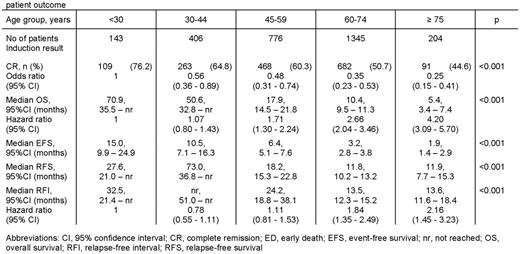Abstract
Abstract 998
Poster Board I-20
Age at diagnosis is a well established prognostic factor in acute myeloid leukemia, since elderly patients exhibit a very bad prognosis compared to younger patients. However, little is known about the influence of age within different age groups.
2874 patients of > 16 years of age were treated in the AMLCG1999 study of the AML Co-operative Group with a standard- and high-dose cytarabine-containing combination induction therapy (TAD/HAM), standard-dose cytarabine containing consolidation therapy (TAD) and different schedules of postremission therapy (allogeneic or autologous stem cell transplantation, maintenance therapy). Patients were grouped into into 5 age categories (< 30 years, 30 – 44, 45 – 59, 60 – 74 and ≥ 75 years) and were analyzed for remission rate (RR), overall survival (OS), event-free survival (EFS), relapse-free survival (RFS) and freedom from relapse (relapse free interval, RFI).
The RR after an intensive induction therapy steadily declined from 76.2% to 44.6% with increasing age (see table). However, despite the superior RR in patients < 30 years these patients displayed a not significantly decreased RFS and RFI in the postremission phase compared to the age group 30 – 44 years. As a result, OS and EFS did not differ between the age groups < 30 years and 30-44 years but decreased with increasing age for the age groups < 45, 45 – 59, 60 – 74 and ≥ 75 years. Younger patients displayed leukocytes > 20,000/μl more often (51.1%, 46.5%, 37.4%, 34.6%, 40.4% for the age groups < 30, 30-44, 45 – 59, 60 – 74 and ≥ 75 years respectively), a higher amount of patients with elevated LDH > 700U/l (39.0%, 31.3%, 24.3%, 20.4%, 20.2%), a higher amount of low risk cytogenetics as defined by the presence of CBF aberrations (20.9%, 14.6%, 8.3%, 3.7%, 4.8%) and the lowest incidence of high risk cytogenetics (19.4%, 20.8%, 23.4%, 29.6%, 21.9%). When adjusted for these risk factors in a multivariate analysis, age remained an independent factor for RR together with the cytogenetic risk profile. Age remained a significant adverse prognostic factor for OS in a multivariate analysis showing a decrease for the age groups < 45 years, 45 – 59 years, 60 – 74 years and ≥ 75 years. RFI was significantly worse in the age group ≥ 60 years versus < 60 years but did not differ within these age groups.
Taken together, we found age to be a continuous adverse risk factor for the probability of a complete remission in adult AML patients above 30 years of age at diagnosis receiving an intensive induction treatment. Age has previously been shown to be the strongest independent prognostic factor when patients are stratified between the age groups < 60 and ≥ 60 years of age. In our analysis, we could also demonstrate an influence of the age on overall survival within these age groups.
No relevant conflicts of interest to declare.
Author notes
Asterisk with author names denotes non-ASH members.


This feature is available to Subscribers Only
Sign In or Create an Account Close Modal